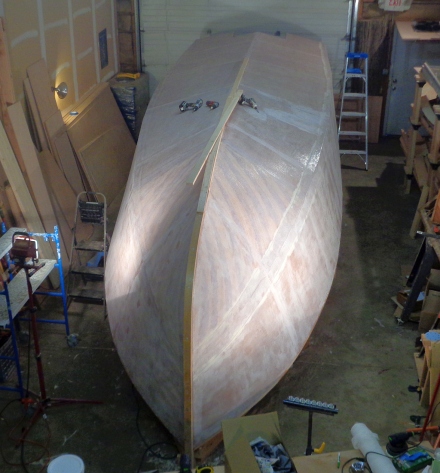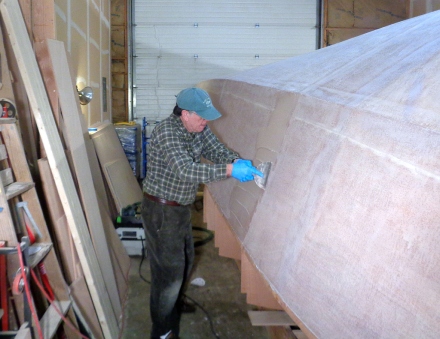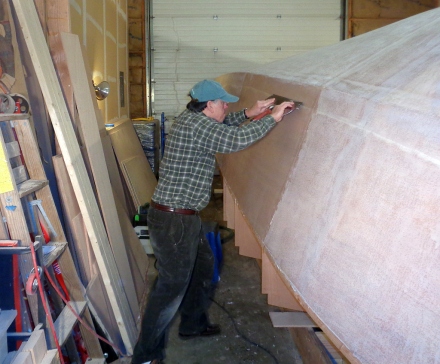February 12, 2015 Hours spent building to date: 815
I have been sanding the hull now for 12 straight days, less one off for a blizzard. I might have been sanding until son John hauls us off to Assisted Living, but for the help of follower Scott Curry.
The problem with sanding a fiberglass boat is that an optimal glassing job puts the epoxy just over the top of the weave of the glass. If you sand too deeply in the quest to get the hull perfectly smooth, the glass gets cut and strength is lost. This is an even bigger problem with Xynole, which doesn’t really cut due to its strength, but turns to a sort of unpaintable fur. So to be on the safe side, I covered the wet-out coat with four more coats of rolled-on epoxy.
But as I sanded and sanded with 40-grit paper on a rotary sander, 80 on the rotary, and 80 on a random orbit, I felt I was getting down to the glass, but still had a lot of imperfections — areas where epoxy had dripped, slight dips in the underlying plywood, areas where the epoxy had soaked in differently to the cloth due to temperature or humidity or whatever. You could barely see them, but you could feel them, and they were too deep for primer to fill.
So I rolled on a SIXTH coat of epoxy into one are of the boat, sanded yet again, but it still wasn’t quite right — even after sanding off 90% of the epoxy.
My only thought at this time was to mix up some microballoon filler and laboriously fill every little pit with a putty knife a bit at a time — emptying a swimming pool with a teacup. Then Scott sent me pictures and an article from WEST on “screeding” fairing compound onto a boat with a process a lot like leveling a concrete patio (see Scott’s comments). I really didn’t need to “fair” the boat much more — it is plywood after all, fairly flat, and I had worked like a dog to get it fair after framing. But a modified screeding technique to fill the dings would save me days.
So I bought a 20-inch taping knife from Amazon for overnight delivery and a gallon of System Three QuickFair compound on the express truck from Jamestown. That made all the difference. The QuickFair is much easier to use than microballoons, which slip around in the epoxy and are difficult to mix. You just take two measures of Part A, stir with one Part B and a creamy, spreadable mix results with the same consistency every time. I actually used a diet scale to weigh the compound, probably the only real success the little gizmo has ever known.
The procedure is pretty simple once you get the hang of it: mix up a pint of Quickfair, apply it as a sort of bead vertically on the boat, spread it out as thin as you can horizontally and still fill the pits in the epoxy, take the big knife and screed it vertically down the hull in one pass. Then sand and fill any misses the next day. At first I put it on too thick as if I was fairing out low spots. But all I wanted was to fix imperfections, so six ounces covers about four feet of boat.
The topsides are all done in probably just 12-14 hours work. There are still highs and lows that will show, since after all, this is a wooden boat. But as to smoothness, I think we have reached the area I always strive for somewhere between good enough and pretty good.








I am so glad that this technique has helped. Sanding for days seems to be the worse part of boat building. We tried both System three and awl fair. Awl fair screeds better and sands easier. That’s what all the professionals use according to my cousin Kevin. We realized after sanding for days on our project that anything below the water wasn’t as critical as what was above. So we spent all our effort on what the eye would see. It’s hard to know when to stop the process of fairing. It is definitely an acquired art skill. After we were satisfied filling all the major lows, we then proceeded to shoot a high build primer over 20 mils thick. This was then long boarded and finally DA sanded.
LikeLike